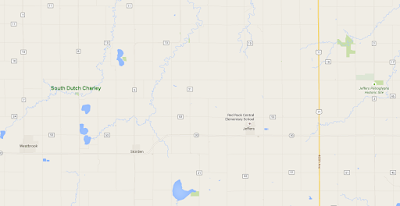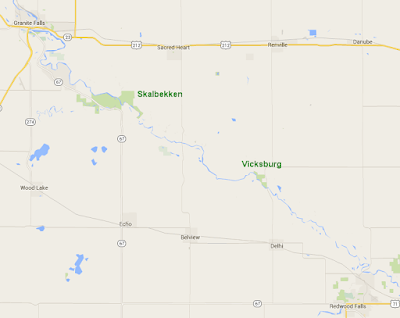Minneapolis and St. Paul create a substantial amount of light pollution. Even at a distance of about 50 miles their combined light dome will show up clearly in long exposures. Where can one go to find really dark skies for all-night imaging?
Existing
Minnesota Astronomical Society (MAS) sites are either not very dark or are distant: Cherry Grove Observatory (about an hour away, between light green and dark yellow sky as used by
Light Pollution Atlas 2006), Eagle Lake Observatory (3/4 hour, light yellow), J. J. Casby Observatory (half hour, light orange), Long Lake Conservation Center (2 3/4 hours, light blue), and Crex Meadows (not an official MAS site, 2 hours, light blue).
These are either too bright (Cherry Grove, Eagle Lake, Belwin), too far (LLCC) or lacking in any accommodations (Crex). LLCC use is limited to specific weekends, eliminating the ability to take advantage of weeknight clear sky opportunities.
I spent some time doing an initial survey of what's available in the 2 to 3 hour driving range. I've looked at Lake Shetek state park previously; it's very nice, good horizons, electricity, green zone dark, and no reservations are needed during off-peak times (i.e., Labor Day through October). This park is busy at other times, though, and reservations are needed. Given the fickle weather around here, reservations are a good way of throwing one's money away. Here's what I mean:
State Park camping reservations work like this in Minnesota in 2015: A standard drive-in rustic campsite (no electric) is $15 to $19 per night.
Let's take an example of a two-night imaging trip: Getting the reservation is at least $38.50 (this assumes a $15 nightly fee and includes the $8.50 online reservation fee (use the phone instead and it's a $10 fee). Cancelling four days in advance will get you only $20 back (The $38.50 less the reservation fee less a $10 cancellation charge. You're out $18.50. Cancel later than that--which is more likely going to be the case given the quality of cloud cover forecasts--and you only get $3.50 back because the first night's charge of $15 is forfeited. You're out $35.
Another difficulty with state parks in general is their tendency to put campgrounds in wooded areas (Lake Shetek is a wonderful exception). There are a number of parks under dark skies, but if you put your gear up next to your tent (as I do) it's going to be under trees.
The good thing about State parks is that after labor day they tend to empty out and it's often possible to obtain camp sites without going through the reservation system. Lake Shetek would be great for this in September and October.
Parks that don't require reservations such as those administered by counties are easier to use. Generally they don't have much in the way of facilities, but if you're used to primitive camping at star parties that's perfectly fine. Are there any dark-sky parks that look like candidates within a few hours drive from the Cities?
Yes, and they're surprisingly dark.
Cottonwood county's South Dutch Charley (also spelled Charlie) County Park is little more than a wooded lot, but it sits under light blue zone sky that's 2.5 hours drive away. Google Earth images suggest that it may have some places to camp that allow a southern view. At $10 a night you don't get much beyond a shelter and pit toilet, but when one can carry one's own power that's no problem. SDC is in familiar territory sitting only 16 miles west of Jeffers Petroglyphs.
 |
| Location of South Dutch Charley Park |
Renville county's Vicksburg County Park (aka County Park No. 2) is a little larger and is 2.1 hours away. $12 a night for camping, its sky is on the line between light blue and dark green. Because this park sits next to the Minnesota River it will probably have plenty of mosquitoes during summer, but spring and fall visits may be pleasant.
Skalbekken County Park (aka Renville County Park No. 1, 2.2 hours away) is farther up the river and under dark green skies. It's farther from Redwood Falls than Vicksburg is, reducing its light dome to the SE. On the other hand, the dome from Granite Falls to the NW will be substantially brighter.
 |
| Locations of Skalbekken and Vicksburg County Parks |
Here's how these two areas are located relative to the Twin Cities:
 |
| Yes, one has to drive this far to find blue zone sky. |
I'll visit all of these sites in June and July to see if they are suitable for imaging trips.
ADDED:
Another dark sky camping location is in Iowa, 6.5 miles WSW of Rice in Mitchell County. It has light blue zone sky and is about 2 1/4 hours from my location. $10 camping with electrical hookups available. Worth checking out, probably on the return trip from this year's Eastern Iowa Star Party (assuming I'm able to attend).
Here's a map of the proposed sites showing the Atlas 2006 sky brightness. I've include my location and some other fairly dark sites mentioned in this post.
I looked at Wisconsin and NW of the Twin Cities, but couldn't find anyplace worth mentioning. The nice dark blue area south of LLCC seems to be mostly forests, but it contains one possible site: Snake River County Park. Aerial pictures of the camping area suggest it's forested, but it is worth a look on my next trip to LLCC (probably next summer).
ADDED 5/27: Another camping area only an hour and a half from home is Clear Lake Park in Sibley county. It's in a light green zone and about 11 miles north of New Ulm so there's going to be a substantial light dome to deal with. Camping is free (you need to get permission from the county Sheriff's office) and it looks like there may be considerable open space in which to set up.
ADD 5/58: Let's add a few more possibilities. Lake Hanska County Park is a light green zone park a little under two hours away. Blue zone camping can be found at Garvin County Park 7 miles WNW of Tracy. More blue zone at Oraas Park South of Clarkfield. All of these have inexpensive tent camping.
Maybe it's time to summarize these in a table:
|
SITE
|
ZONE
|
DRIVE
|
FEE
|
LOC
|
Elec
|
H2O
|
NOTE
|
|
|
L
Green
|
1:31
|
?
|
10
NNW New Ulm
|
N
|
Y
|
1
|
|
|
L
Blue
|
2:51
|
$10
|
7
WNW Tracy
|
Y
|
Y
|
2
|
|
|
L
Green
|
1:53
|
$10
|
9 NW
Madelia
|
|
|
|
|
|
L
Blue
|
2:38
|
$5
|
7 S
Clarkfield
16 SW Granite Falls
|
Y
|
Y
|
|
|
|
L
Blue
|
2:19
|
$10
|
6
WSW Riceville
|
Y
|
Y
|
|
|
Skalbekken
|
D
Green
|
2:17
|
?
|
8 SE
Granite Falls
|
N?
|
N?
|
3
|
|
|
L
Blue
|
2:33
|
$10
|
4 NE
Westbrook
|
?
|
Y
|
4
|
|
Vicksburg
|
L
Blue
|
2:06
|
?
|
10
NW Redwood Falls
|
?
|
?
|
3
|
NOTES
(1) Probable substantial light dome to south; must contact Sheriff’s office to
OK stay
(2) Almost all campsites have electricity (extra $5)
(3) Very forested; no direct link at present from county web site.
(4) Open through end of October (most are open only until October 15)
At this point I'm most inclined to opt for South Dutch Charley and Garvin. Garvin in particular is attractive because of it having electricity, and aerial views suggest some campsites have passable horizons.
Sadly I couldn't find any dark blue zones within reasonable driving distance unless one goes into South Dakota or north into the forests of Minnesota. There are a few light gray zones near the SD border, but as you might expect they're devoid of campgrounds.










